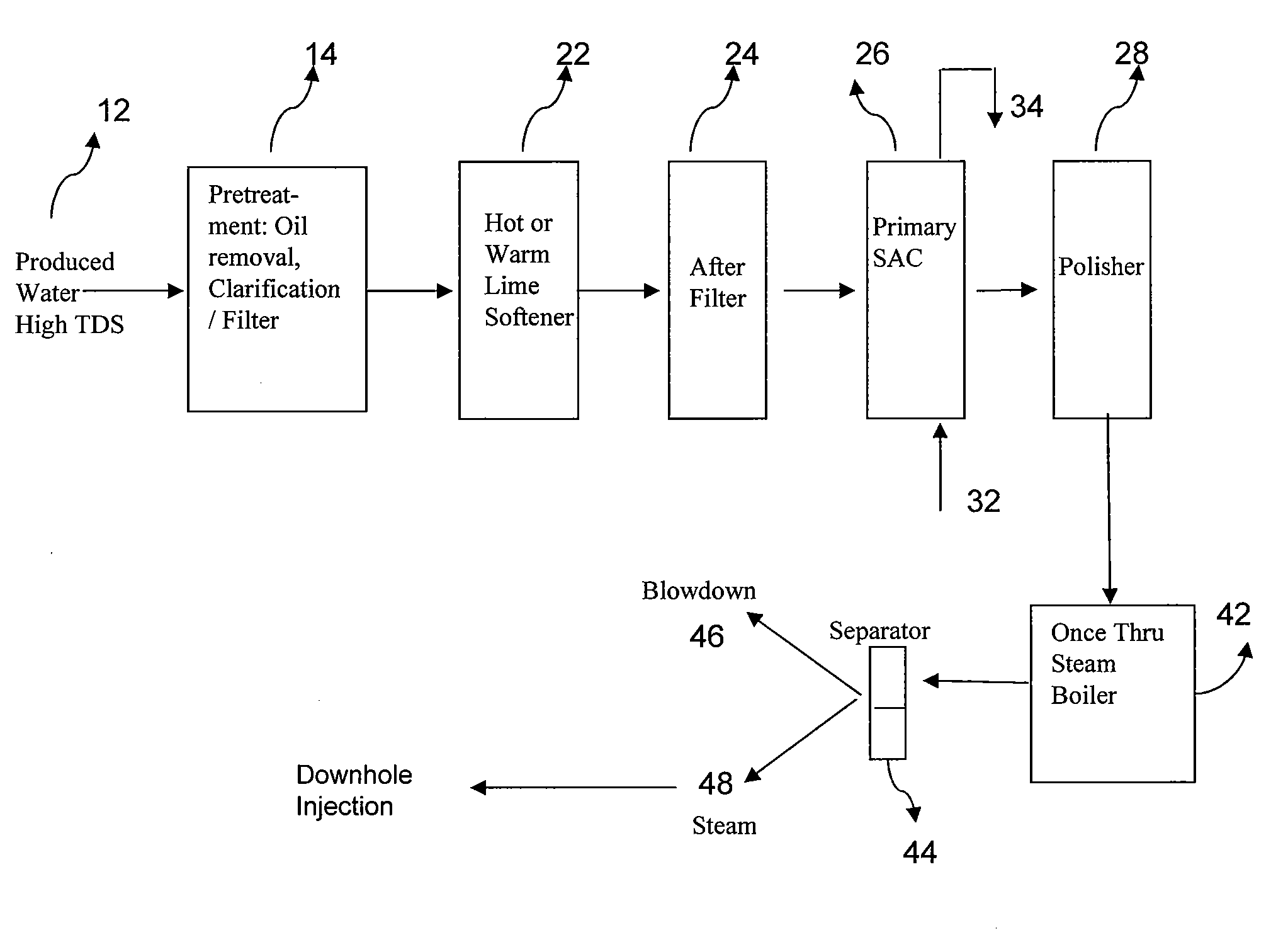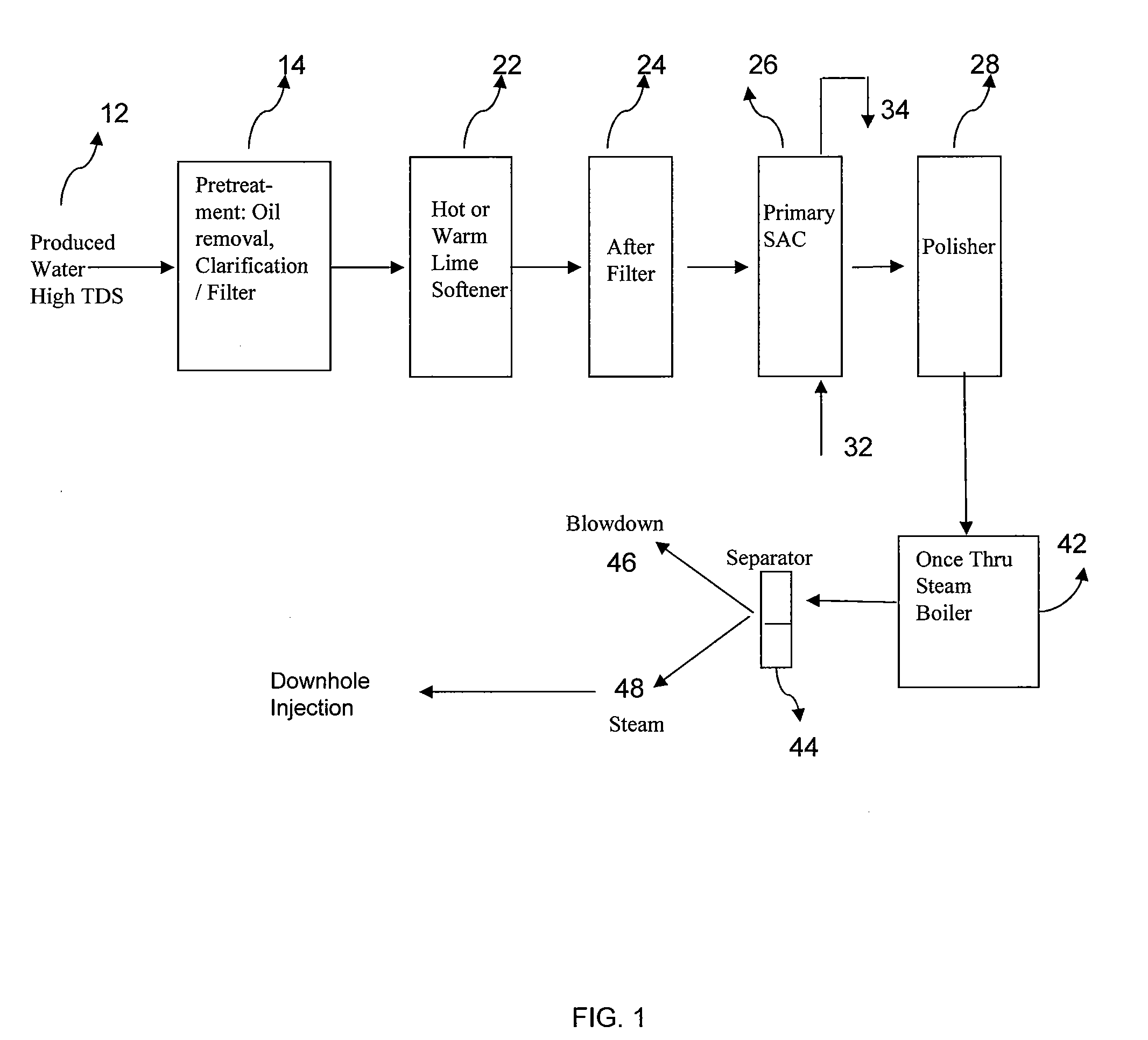Water softener regeneration
a water softener and water softener technology, applied in the direction of steam generation plants, lighting and heating apparatus, separation processes, etc., can solve the problems of increasing the potential for rupture and failure of boilers, reducing heat transfer efficiency, and increasing the operating cost of sal
- Summary
- Abstract
- Description
- Claims
- Application Information
AI Technical Summary
Benefits of technology
Problems solved by technology
Method used
Image
Examples
example 1
Part A
[0117]A Steam Assisted Gravity Drainage system having a Once-Through Steam Generators (OTSGs) has the following parameters:[0118]Influent water TDS—4000 ppm as CaCO3;[0119]Sodium chloride content—3800 ppm as CaCO3 (76 meq NaCl per liter);[0120]Total Hardness—200 ppm as CaCO3 (4 meq total hardness per liter of water);[0121]Conventional Softener operating capacity: 300 bed volumes (BVs) in a vessel containing Purolite® C100 (or, optionally, the SAC vessel contains Purolite® SST80DL);[0122](1 bed volume of treated water is equal to 1 volume of resin used to treat the water)[0123]Hardness leakage is estimated at no greater than 1 meq / l or 50 ppm as CaCO3 based on softener design tables available from Purolite for Purolite C100®[0124]Net quantity of hardness exchanged onto the resin: 300BVs×3 meq / l=900 meq per liter of resin;
[0125]A conventional SAC water softener system used in SAGD operations typically uses salt dosages ranging from 15 to 25 lbs of sodium chloride salt per cubic ...
example 2
[0135]A Steam Assisted Gravity Drainage system having a Once-Through Steam Generators (OTSGs) has the following parameters:[0136]Influent water TDS—4000 ppm as CaCO3;[0137]Sodium chloride content—3800 ppm as CaCO3 (76 meq NaCl per liter);[0138]Total Hardness—200 ppm as CaCO3 (4 meq total hardness per liter of water);
[0139]It is desired to calculate the minimum hardness leakage possible when the softener is operated counterflow with the service water and regenerant brine entering the softener vessel in opposite directions. Thus, leakages for with various grades of salt versus regenerating the softener with the brine from the OTSG blowdown can be compared. Rock salt, solar salt and vacuum salt are compared in the table below with the use of the OTSG blowdown brine as a regenerant. Rock salt, solar salt and vacuum salt are compared at 10% brine concentration with the typical hardness levels for these grades versus OTSG brine available at 2% concentration with a maximum hardness level o...
example 3
[0143]A Steam Assisted Gravity Drainage system having a Once-Through Steam Generators (OTSGs) has the following parameters:[0144]Influent water TDS—12000 ppm as CaCO3;[0145]Sodium chloride content—11700 ppm as CaCO3 (234 meq NaCl per liter);[0146]Total Hardness—300 ppm as CaCO3 (6 meq total hardness per liter of water);
[0147]A twin alternating softener system that uses the OTSG brine as regenerant is designed so one softener will be in service, softening the influent water, while the other will be simultaneously regenerated using brine recovered via the OTSG blowdown. The system is designed to provide maximum hardness leakage of 0.2 ppm.
[0148]The solution uses a counterflow operated twin tank softener system with flow characteristics as shown in FIG. 4, in which SAC1 is in service softening the influent water while SAC 2 in being regenerated with the cooled blowdown brine from the OTSG. The valving and control system (36) is designed to switch SAC 1 out of service and into regenerat...
PUM
| Property | Measurement | Unit |
|---|---|---|
| Temperature | aaaaa | aaaaa |
| Fraction | aaaaa | aaaaa |
| Fraction | aaaaa | aaaaa |
Abstract
Description
Claims
Application Information
 Login to View More
Login to View More - R&D
- Intellectual Property
- Life Sciences
- Materials
- Tech Scout
- Unparalleled Data Quality
- Higher Quality Content
- 60% Fewer Hallucinations
Browse by: Latest US Patents, China's latest patents, Technical Efficacy Thesaurus, Application Domain, Technology Topic, Popular Technical Reports.
© 2025 PatSnap. All rights reserved.Legal|Privacy policy|Modern Slavery Act Transparency Statement|Sitemap|About US| Contact US: help@patsnap.com



